Tragedy in Ahmedabad, India with the crash of an Air India B-787-8...
These are the stories for today.
Be safe out there!
Tom
What we know about the Air India plane crash
By Sophie Tanno, Antoinette Radford, Rhea Mogul, Aishwarya S. Iyer and Christian Edwards, CNN
CNN -An Air India plane bound for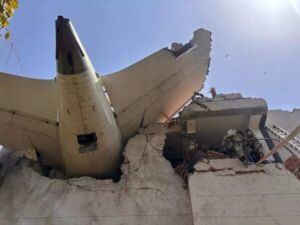 London carrying 242 people crashed shortly after take-off in western India on Friday.
London carrying 242 people crashed shortly after take-off in western India on Friday.
Videos showed a huge plume of black smoke billowing into the sky. Rescue workers have scrambled to put out the fire and search for potential survivors.
Here’s what we know.
What happened and when?
The flight, AI171, took off at 1:39 p.m. local time (4:09 a.m. ET) from Ahmedabad’s Sardar Vallabhbhai Patel International Airport in India’s western state of Gujarat, according to a statement from India’s Directorate General of Civil Aviation. It was headed to London Gatwick, and scheduled to land at 6:25 p.m. local time (1:25 p.m. ET).
But shortly after take-off, the plane gave a Mayday call to air traffic control (ATC), the Indian civil aviation authorities said.
“Thereafter no response was given by the aircraft to the calls made by ATC. Aircraft immediately after departure from Runway 23, fell on ground outside the airport perimeter,” the statement said.
The plane had reached an altitude of 625 when its signal was lost, according to data from flight tracker FlightRadar24.
Videos showed the Boeing 787-8 Dreamliner descending, before disappearing behind buildings and bursting into a fireball.
Gujarat is also the home state of India’s Prime Minister Narendra Modi. Modi was chief minister of the state from 2001 to 2014.
The plane hit a hostel for doctors when it crashed, with images showing the tail of the plane protruding from the building. In the debris-strewn street below, rescue workers rushed to put out the flames and search among the charred wreckage for survivors.
What plane was involved?
The crash is the first major incident involving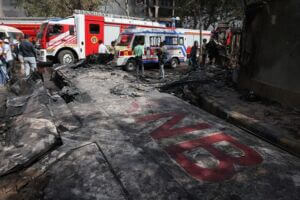 a Boeing 787 Dreamliner since the aircraft first came into service in 2011, according to the aircraft maker.
a Boeing 787 Dreamliner since the aircraft first came into service in 2011, according to the aircraft maker.
Boeing said it is “working to gather more information” about the crash.
The manufacturer said there are more than 1,175 Dreamliner passenger aircrafts in service, accounting for 2,100 flights each day.
Aviation analyst Geoffrey Thomas told CNN the Boeing had “just celebrated a billion passengers” on its 787 Dreamliners.
Shares in Boeing tanked by more than 7% in pre-market trade Thursday following the crash of one of its passenger aircraft in India.
Stocks in many other airlines also fell, including London-listed IAG – the parent company of British Airways. Shares in Germany’s Lufthansa, United Airlines, American Airlines and Delta Air Lines also fell on Thursday.
Who was on board?
Air India said there were 169 Indian nationals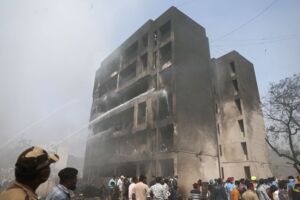 on the flight, in addition to 53 Britons, seven Portuguese and one Canadian.
on the flight, in addition to 53 Britons, seven Portuguese and one Canadian.
The UK and India have strong cultural ties and a complicated history dating back to Britain’s colonial era. There is a large Indian diaspora in the UK of about 1.9 million people – or 3.1% of the population – according to the latest census data in 2021.
The Ahmedabad city police commissioner told the Associated Press that there appears to be no survivors from the crash.
Modi said the crash was “heartbreaking beyond words” and that he was in touch with the authorities involved in the disaster. British Prime Minister Keir Starmer said the scenes were “devastating.”
Natarajan Chandrasekaran, the chairman of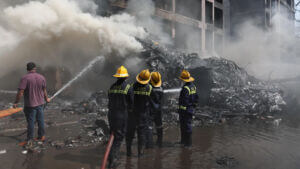 Air India, said the carrier was “doing everything in our power to assist the emergency response teams at the site and to provide all necessary support and care to those impacted.”
Air India, said the carrier was “doing everything in our power to assist the emergency response teams at the site and to provide all necessary support and care to those impacted.”
How rare are incidents like this?
If the death toll is confirmed the crash is the deadliest worldwide since 2014 when a Malaysia Airlines jet was shot down over eastern Ukraine, killing all 298 people on board.
Air India was bought by Indian multinational conglomerate Tata Group in 2022, and was widely regarded as a historic homecoming. Originally founded by J.R.D. Tata in 1932 before being nationalized in 1953, the deal marked the return of Air India to its original owners after nearly 70 years of government control.
Prior to the purchase, Air India was seen as a struggling, debt-ridden airline. The carrier has seen a few rare but high-profile plane crashes in recent years.
In 2020, at least 18 people died in 2020 after an Air India Express plane – a wholly owned subsidiary of Air India – crashed in the southern state of Kerala after skidding off the runway.
In 2018, an Air India Boeing 737 aircraft was damaged after hitting an airport wall during takeoff.
And in 2010, 158 people were killed after an Air India plane crashed after the jet overshot a runway in southern India.
These incidents spurred Indian authorities to improve safety and infrastructure, but challenges remain, including airspace congestion.
Since Air India’s 2022 acquisition, the airline has undergone a significant transformation and modernization effort as it looks to tap into the demand of India’s burgeoning middle class.
CNN’s Olivia Kemp, James Frater and Anna Cooban contributed reporting.
https://www.cnn.com/2025/06/12/india/air-india-plane-crash-intl
Transair plane with landing gear issues makes hard landing at Honolulu airport
Short SD3-60 aircraft had similar issue in 2015
By Annalisa Burgos
HONOLULU (HawaiiNewsNow) - A small plane experiencing landing gear issues made a hard landing at Honolulu’s Airport around 9 a.m. Wednesday.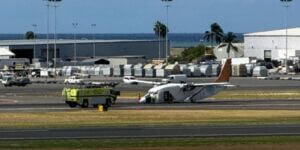
Authorities say Transair flight R96, a Short SD3-60 turboprop aircraft, had five people on board. No one was hurt.
FlightAware shows the plane departed Kona airport for Honolulu at 8 a.m. Around 8:50 a.m., a witness captured video of the plane approaching Runway 4R of Daniel K. Inouye International Airport near Lagoon Drive.
Witnesses say they were surprised to see the plane’s landing gears still up when it was already over the runway, unusual when a plane is close to the ground.
Another witness video shows the turboprop aircraft sitting on the north end of the runway with its undercarriage fully on the ground.
A Federal Aviation Administration (FAA) spokesperson said the plane’s landing gear collapsed when the plane touched down in Honolulu.
The Hawaii Department of Transportation said Aircraft Rescue and Fire Fighting (ARFF) responded, and flights were diverted to Runway 8L. Crews towed the plane at 1 p.m. Officials said there was no damage to the runway and there were no disruptions to flight operations.
Aviation experts say landing gear issues are common for older planes and may or may not be detected during maintenance and inspections.
“Every 100 hours they’re checking the airplane out and they’re looking for cracks and things, but sometimes it’s really hard to tell,” said aviation expert Peter Forman.
Potential causes include mechanical failure or pilot error.
“With professional air crews, it’s usually maintenance-related or simply metal fatigue-type things rather than pilot-related,” he added. “If it’s a pilot error, usually it’s very obvious because it starts sliding as soon as the airplane touches down.”
An NTSB report shows the same Transair Short SD3-60 turboprop aircraft experienced a gear-up landing at the Kalaeloa Airport in June 2015 that caused “substantial damage” to the plane. Investigators found the pilots failed to extend the landing gear before landing and failed to complete the Before Landing checklist.
Transair’s parent company, Rhoades Aviation, has been under federal scrutiny over the past four years, after one of its Boeing 737 jets made an emergency water landing off the coast of Oahu. The two pilots survived, but the FAA grounded Transair’s 737 fleet for alleged safety violations and maintenance issues.
Transair continues to operate unscheduled passenger and cargo charter flights with a small fleet of mostly short turboprop aircraft.
Transair has said it plans to resume scheduled interisland service by the end of this year, after the FAA’s move to shut it down was dismissed.
We reached out to Transair for comment but have not heard back.
“Every time there is a mechanical issue, it’s a strike against you, that’s for sure,” Forman said. “These airplanes are about 40 years old, though, so that does make it more likely that something is gonna fail at some point.”
FAA says its investigation is ongoing.
https://www.hawaiinewsnow.com/2025/06/11/transair-plane-with-landing-gear-issues-makes-hard-landing-honolulu-airport/
NTSB Final Report: Just Highlander
Airplane Was On Short Final To Land On A Grass Airstrip, Close To The Ground, The Wing Flaps Retracted From 40° To 0° Uncommanded
Location: Oshkosh, Wisconsin Accident Number: CEN24LA282
Date & Time: July 20, 2024, 17:21 Local Registration: N707KM
Aircraft: Just Highlander Aircraft Damage: Substantial
Defining Event: Hard landing Injuries: 2 None
Flight Conducted Under: Part 91: General aviation - Personal
Analysis: The pilot reported that when the airplane was on short final to land on a grass airstrip, close to the ground, the wing flaps retracted from 40° to 0° uncommanded, and the airplane started to sink. The pilot added engine power to arrest the descent; however, the airplane landed hard. The pilot taxied the airplane without further incident. A postlanding examination of the airframe revealed substantial damage to the fuselage on the right side.
After the accident, the flaps were manipulated in and out of the fully extended flap position using the flap actuator handle. The flap controls were continuous and extended and retracted as designed. The flap actuator handle always remained secure in the detent. Investigators were unable to duplicate the uncommanded retraction of the flaps from 40° to 0°. There were no mechanical anomalies with the airplane or related systems that would have precluded normal operations.
Probable Cause and Findings: The National Transportation Safety Board determines the probable cause(s) of this accident to be -- The reported uncommanded retraction of the flaps while on short final for unknown reasons, which resulted in a hard landing.
FMI: www.ntsb.gov
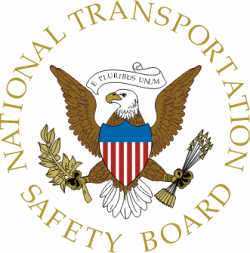
Today in History
75 Years ago today: On 12 June 1950 An Air France Douglas DC-4 crashed into the sea while on approach to Bahrain Airport, Bahrain , killing 46 occupants; 6 survived the accident.
| Date: | Monday 12 June 1950 |
| Time: | 21:15 |
| Type: | Douglas DC-4-1009 |
| Owner/operator: | Air France |
| Registration: | F-BBDE |
| MSN: | 42937 |
| Year of manufacture: | 1946 |
| Fatalities: | Fatalities: 46 / Occupants: 52 |
| Other fatalities: | 0 |
| Aircraft damage: | Destroyed, written off |
| Category: | Accident |
| Location: | 5,5 km SE off Bahrain Airport (BAH) - Bahrain |
| Phase: | Approach |
| Nature: | Passenger - Scheduled |
| Departure airport: | Karachi International Airport (KHI/OPKC) |
| Destination airport: | Bahrain International Airport (BAH/OBBI) |
| Investigating agency: | BEA |
| Confidence Rating: | Accident investigation report completed and information captured |
Narrative:
An Air France Douglas DC-4 crashed into the sea while on approach to Bahrain Airport, Bahrain , killing 46 occupants; 6 survived the accident.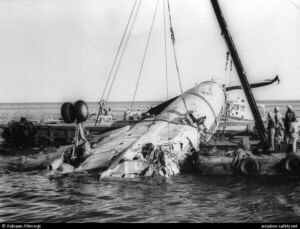
The Air France DC-4 was on a scheduled flight from Saigon to Paris. It took off from Karachi (KHI) for Bahrain (BAH) at 16:05. At 20:42 the aircraft called Bahrain approach control giving its altitude as 6500 feet and requesting clearance to descend. Approach control gave clearance to descend to 2000 feet, altimeter setting of 29.51 inches, visibility 1500 yards (1370 metres).
The airplane overflew the airfield at a height of about 1000 feet. At 21:13 the aircraft called Bahrain tower, saying "down wind leg"; the tower acknowledged and said "ground wind 310/20 knots", the aircraft called the tower at 21:15 hours saying "finals" . The tower controller cleared the flight to land on runway 29. On finals the airplane contacted the water and crashed. The wreckage was found in 12 feet of water, 3,3 miles from the runway end 8 hours after the accident.
Two days later an Air France DC-4 on the same flight leg also crashed while on approach to Bahrain at night, killing 40 occupants.
PROBABLE CAUSE: "The pilot-in-command did not keep an accurate check of his altitude and rate of descent during the timed approach procedure, thus allowing his aircraft to fly into the surface of the sea. The possibility that the pilot-in-command was feeling the effects of fatigue cannot be ruled out. It is recommended that consideration be given to equipping Bahrain Airport with radio landing aids and with suitable runway approach lights."
![]()